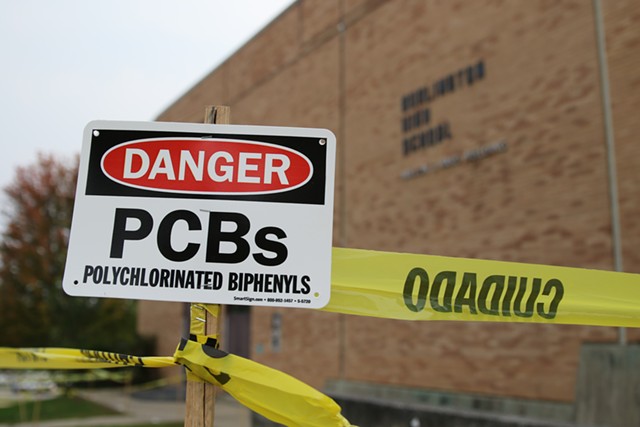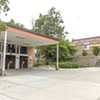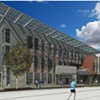
- Courtney Lamdin ©️ Seven Days
- A sign in front of Burlington High School
Burlington High School and the Burlington Technical Center will remain closed for the remainder of the semester as the district investigates the presence of carcinogenic chemicals in the air.
Superintendent Tom Flanagan's announcement on Wednesday night
follows the revelation last week that the district detected high levels of polychlorinated biphenyls, or PCBs, in the air of F Building, which houses classrooms for Burlington Technical Center and for special education students.
The school year had just begun when Flanagan announced on September 9 that classes would pivot to all-virtual instruction until September 21. That date is now pushed back at least four months.
"I know this news must come as a shock to many of you, and I know that many students are likely very disappointed to once again be missing out on so many in-person connections," Flanagan wrote in an email to parents on Wednesday. "I want to assure you that we will work as fast and as hard as we can to get students back into our buildings as soon as we can."
PCBs are man-made chemicals frequently found in window caulking and light fixtures in buildings constructed between 1950 and 1979, after which time the U.S. Environmental Protection Agency banned their use. Health effects from PCBs, cancer-causing and otherwise, depend on how long and how often a person is exposed to the chemicals.
The school district began testing for hazardous materials last summer in preparation for a $70 million school renovation, known as the ReEnvisioning project, that
city voters approved in November 2018.
Consultants have since performed air and other tests, the latest of which concluded that PCBs in various rooms of the F Building measured between 160 and approximately 6,000 nanograms per cubic meter. The EPA recommends that the readings for rooms in which high school-aged students spend time be less than 600 nanograms per cubic meter. Vermont Department of Health standards are even stricter, at less than 15 nanograms per cubic meter.
The health department "made a strong recommendation that we not return to BHS or BTC without further diagnosing and mitigating the issue of PCB's in the air," Flanagan wrote.
At least one reading in all other buildings exceeded the state standard but not the EPA's, according to new results released on Wednesday night. The highest reading in A Building, home to the cafeteria and gymnasium, was 260 nanograms per cubic meter in the chorus room. B Building's highest measurement of 270 nanograms per cubic meter was found in the library office.
The highest readings in Buildings C, D and E were 130, 300 and 110 nanograms per cubic meter, respectively.
The cafeteria and kitchen, however, both measured at acceptable levels and will remain open, Flanagan said. The EPA and state health department told Flanagan that it would be safe to continue using those spaces as long as they "keep an eye on the spaces and include them in future testing," the superintendent said.
"This is good news for us as a District, as the kitchen at BHS is used to prepare food for many students and community members, not just our BHS population," Flanagan wrote.
While the high school buildings could reopen after four months, Flanagan said he expects the testing and mitigation process at the Burlington Technical Center to take "significantly longer." The district is seeking alternative classrooms for those programs.
Flanagan also tried to assuage concerns from teachers and staff, writing that "our Human Resources team is actively working with our insurance and benefits providers to explore what these results mean and how we can help and support you."
At a school board meeting on Tuesday, senior finance director Nathan Lavery told commissioners that the district would look into emergency funding from the state to help cover remediation costs. Flanagan's email noted that "even the least-costly mitigation options will be expensive and time-consuming."
The district is also likely to miss its summer 2021 construction start date, school officials said on Tuesday night.
Read the building summary reports below.
Correction, September 17, 2020: A previous version misreported when the consultants first tested the air quality in the buildings.


















Comments
Comments are closed.
From 2014-2020, Seven Days allowed readers to comment on all stories posted on our website. While we've appreciated the suggestions and insights, right now Seven Days is prioritizing our core mission — producing high-quality, responsible local journalism — over moderating online debates between readers.
To criticize, correct or praise our reporting, please send us a letter to the editor or send us a tip. We’ll check it out and report the results.
Online comments may return when we have better tech tools for managing them. Thanks for reading.